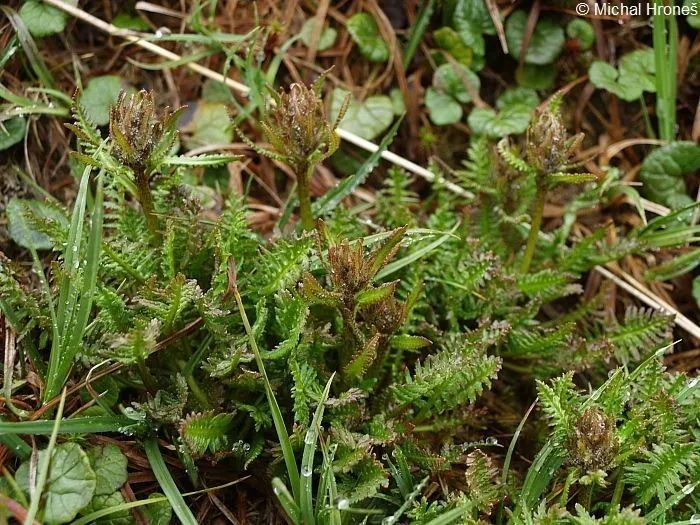
Author: Willd.
Bibliography: Sp. Pl., ed. 4, 3: 209 (1800)
Year: 1800
Status: accepted
Rank: species
Genus: Pedicularis
Vegetable: False
Observations: Sudeten Mts., Russia (Ural’skiy Chrebet)
Sudetic lousewort, scientifically known as Pedicularis sudetica, is a captivating, herbaceous perennial plant belonging to the Orobanchaceae family. Originating from specific European and Russian regions, this species is notably found in the Sudeten Mountains and the Ural Mountains’ range in Russia. These locales provide the unique mountainous and subalpine environments that Sudetic louseworts thrive in, showcasing their adaptation to hardy climates.
First described in the early 19th century by the botanist Willdenow in the fourth edition of “Species Plantarum” in 1800, Sudetic lousewort has drawn attention for its intriguing structure and ecological significance. Renowned for its hemiparasitic nature, the plant obtains some of its nutrients by attaching to the roots of neighboring plants, a survival strategy common within the Orobanchaceae family.
Sudetic lousewort typically displays vibrant inflorescences consisting of pink to purple flowers. These blooms emerge from a rosette of finely divided leaves that exhibit an exquisite, feather-like appearance. The intricate floral design not only contributes to the plant’s aesthetic appeal but also facilitates pollination by attracting a variety of pollinators, including bees and butterflies.
Studying Pedicularis sudetica provides valuable insights into plant adaptation and survival mechanisms in harsh, mountainous environments. Its presence in these areas also indicates the ecological health of such habitats, making it a species of interest for botanists and ecologists aiming to understand plant biodiversity and conservation needs in alpine ecosystems.
As a member of the diverse and ecologically significant Orobanchaceae family, Sudetic lousewort exemplifies the complex interactions between parasitic plants and their hosts, enriching our understanding of plant relationships and environmental adaptation.
Pol: gnidosz sudecki
Eng: sudetic lousewort, sudeten lousewort, purple rattle
Fra: pédiculaire des sudètes
Ces: všivec krkonošský
En: Sudetic lousewort, Alpine lousewort, Sudeten lousewort, Purple rattle
Cs: Všivec krkonošský
Fi: Sudeettikuusio
Fr: Pédiculaire des Sudètes
De: Sudeten-Läusekraut
Pl: Gnidosz sudecki
Taken Jan 1, 1900 by EOL − Niehaus, T.F. (cc-by-nc-sa)
Taken Jul 5, 2009 by EOL − Michal Hroneš (cc-by-nc)
Taken Jun 20, 2022 by Катя Покрепина (cc-by-sa)
Taken Jun 19, 2009 by EOL − Michal Hroneš (cc-by-nc)
Taken Jan 1, 1900 by EOL − Niehaus, T.F. (cc-by-nc-sa)
Growth habit>: Forb/herb
Family: Myrtaceae Author: (F.Muell.) K.D.Hill & L.A.S.Johnson Bibliography: Telopea 6: 402 (1995) Year: 1995 Status:…
Family: Rubiaceae Author: Pierre ex A.Froehner Bibliography: Notizbl. Bot. Gart. Berlin-Dahlem 1: 237 (1897) Year:…
Family: Sapindaceae Author: Koidz. Bibliography: J. Coll. Sci. Imp. Univ. Tokyo 32(1): 38 (1911) Year:…
Family: Asteraceae Author: A.Gray Bibliography: Pacif. Railr. Rep.: 107 (1857) Year: 1857 Status: accepted Rank:…
Family: Fabaceae Author: Medik. Bibliography: Vorles. Churpfälz. Phys.-Ökon. Ges. 2: 398 (1787) Year: 1787 Status:…
Family: Aspleniaceae Author: (Cav.) Alston Bibliography: Bull. Misc. Inform. Kew 1932: 309 (1932) Year: 1932…